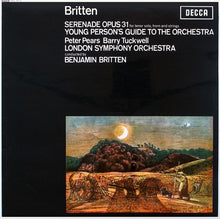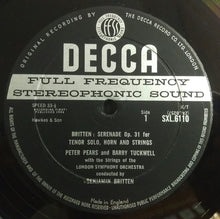Sonic Grade
Side One: 
Side Two: 
Vinyl Grade
Side One: Mint Minus Minus (often quieter than this grade)
Side Two: Mint Minus Minus (often quieter than this grade)
- Superb sound throughout this unboxed UK Decca stereo pressing, with both sides earning solid Double Plus (A++) grades
- It's also exceptionally quiet at the high end of Mint Minus Minus, a grade that even our most well-cared-for vintage classical titles have trouble playing at, and it should be noted that early Decca pressings rarely can be found in this condition
- This is our favorite recording of the work - those of you looking for a Young Person's Guide can stop looking, this is the one
- We've learned from shootouts past (and were reminded again during our most recent) that the London pressing can also be quite good, but none of them can hold a candle to these early Deccas
- For those who have never heard the work, check out The Young Person's Guide on YouTube - it is a tour de force of orchestral excitement, especially the percussion section
More Imported Pressings on Decca and London / More Classical and Orchestral Recordings

100% Money Back Guarantee on all Hot Stampers
FREE Domestic Shipping on all LP orders over $150
Vintage covers for this album are hard to find in exceptionally clean shape. Most of the will have at least some amount of ringwear, seam wear and edge wear. We guarantee that the cover we supply with this Hot Stamper is at least VG
More on The Young Person's Guide...
One of Britten's best known works is The Young Person's Guide to the Orchestra (1946), which was composed to accompany Instruments of the Orchestra, an educational film produced by the British government, narrated and conducted by Malcolm Sargent. Its subtitle is Variations and Fugue on a Theme of Purcell, the theme is a melody from Henry Purcell's Abdelazar.
Britten gives individual variations to each of the sections of the orchestra, starting with the woodwind, then the string instruments, the brass instruments and finally the percussion. He then brings the whole orchestra together again in a fugue before restating the theme to close the work. The original film's spoken commentary is often omitted in concert performances and recordings.
-- Wikipedia
This vintage UK Decca stereo pressing has the kind of Tubey Magical Midrange that modern records can barely BEGIN to reproduce. Folks, that sound is gone and it sure isn't showing signs of coming back. If you love hearing INTO a recording, actually being able to "see" the performers, and feeling as if you are sitting in the studio with the band, this is the record for you. It's what vintage all analog recordings are known for --this sound.
If you exclusively play modern repressings of vintage recordings, I can say without fear of contradiction that you have never heard this kind of sound on vinyl. Old records have it -- not often, and certainly not always -- but maybe one out of a hundred new records do, and those are some pretty long odds.
What The Best Sides Of Serenade Opus 31 / Young Person's Guide To The Orchestra Have To Offer Is Not Hard To Hear
- The biggest, most immediate staging in the largest acoustic space
- The most Tubey Magic, without which you have almost nothing. CDs give you clean and clear. Only the best vintage vinyl pressings offer the kind of Tubey Magic that was on the tapes in 1964
- Tight, note-like, rich, full-bodied bass, with the correct amount of weight down low
- Natural tonality in the midrange -- with all the instruments having the correct timbre
- Transparency and resolution, critical to hearing into the three-dimensional studio space
No doubt there's more but we hope that should do for now. Playing the record is the only way to hear all of the qualities we discuss above, and playing the best pressings against a pile of other copies under rigorously controlled conditions is the only way to find a pressing that sounds as good as this one does.
Copies with rich lower mids and nice extension up top did the best in our shootout, assuming they weren't veiled or smeary of course. So many things can go wrong on a record! We know, we've heard them all.
Top end extension is critical to the sound of the best copies. Lots of old records (and new ones) have no real top end; consequently, the studio or stage will be missing much of its natural air and space, and instruments will lack their full complement of harmonic information.
Tube smear is common to most vintage pressings. The copies that tend to do the best in a shootout will have the least (or none), yet are full-bodied, tubey and rich.
Size and Space
One of the qualities that we don’t talk about on the site nearly enough is the SIZE of the record’s presentation. Some copies of the album just sound small -- they don’t extend all the way to the outside edges of the speakers, and they don’t seem to take up all the space from the floor to the ceiling. In addition, the sound can often be recessed, with a lack of presence and immediacy in the center.
Other copies -- my notes for these copies often read “BIG and BOLD” -- create a huge soundfield, with the music positively jumping out of the speakers. They’re not brighter, they’re not more aggressive, they’re not hyped-up in any way, they’re just bigger and clearer.
And most of the time those very special pressings are just plain more involving. When you hear a copy that does all that -- a copy like this one -- it’s an entirely different listening experience.
What We're Listening For On Serenade Opus 31 / Young Person's Guide To The Orchestra
- Energy for starters. What could be more important than the life of the music?
- The Big Sound comes next -- wall to wall, lots of depth, huge space, three-dimensionality, all that sort of thing.
- Then transient information -- fast, clear, sharp attacks, not the smear and thickness so common to these LPs.
- Powerful bass -- which ties in with good transient information, also the issue of frequency extension further down.
- Next: transparency -- the quality that allows you to hear deep into the soundfield, showing you the space and air around all the instruments.
- Extend the top and bottom and voila, you have The Real Thing -- an honest to goodness Hot Stamper.
Vinyl Condition
Mint Minus Minus and maybe a bit better is about as quiet as any vintage pressing will play, and since only the right vintage pressings have any hope of sounding good on this album, that will most often be the playing condition of the copies we sell. (The copies that are even a bit noisier get listed on the site are seriously reduced prices or traded back in to the local record stores we shop at.)
Those of you looking for quiet vinyl will have to settle for the sound of other pressings and Heavy Vinyl reissues, purchased elsewhere of course as we have no interest in selling records that don't have the vintage analog magic of these wonderful recordings.
If you want to make the trade-off between bad sound and quiet surfaces with whatever Heavy Vinyl pressing might be available, well, that's certainly your prerogative, but we can't imagine losing what's good about this music -- the size, the energy, the presence, the clarity, the weight -- just to hear it with less background noise.
A Must Own Record
We consider this album a masterpiece. It's a recording that belongs in any serious Classical Collection.
Others that belong in that category can be found here.
Side One
- Serenade Opus 31 For Tenor Solo, Horn And Strings
Side Two
- Young Person's Guide To The Orchestra
Serenade for Tenor, Horn and Strings
The Serenade for Tenor, Horn and Strings, Op. 31, is a song cycle written in 1943 by Benjamin Britten for tenor, solo horn and a string orchestra. Composed during the Second World War at the request of the horn player Dennis Brain, it is a setting of a selection of six poems by English poets on the subject of night, including both its calm and its sinister aspects. The poets Britten chose to set for the Serenade range from an anonymous 15th-century writer to poets from the 17th, 18th and 19th centuries.
The settings are framed by a horn prologue and epilogue; Britten had employed a framing device in his 1942 A Ceremony of Carols, and did so again in the prologue and epilogue to Billy Budd. In the Serenade both prologue and epilogue are performed by the horn alone, and in these movements Britten instructs the player to use only the horn's natural harmonics; this lends these short movements a distinctive character, as some harmonics sound sharp or flat to an audience accustomed to the western chromatic scale. The epilogue is to sound from afar, and to this end the final song does not include a part for the horn to allow the player to move off-stage.
The Serenade has eight movements:
- "Prologue" (horn solo)
- "Pastoral", a setting of "The Evening Quatrains" by Charles Cotton (1630–1687)
- "Nocturne", a setting of "Blow, bugle, blow" by Alfred, Lord Tennyson (1809–1892)
- "Elegy", a setting of "The Sick Rose" by William Blake (1757–1827)
- "Dirge", a setting of the anonymous "Lyke-Wake Dirge" (15th century)
- "Hymn", a setting of "Hymn to Diana" by Ben Jonson (1572–1637)
- "Sonnet", a setting of "To Sleep" by John Keats (1795–1821)
- "Epilogue" (horn solo; reprise of Prologue, played offstage)
- Wikipedia




